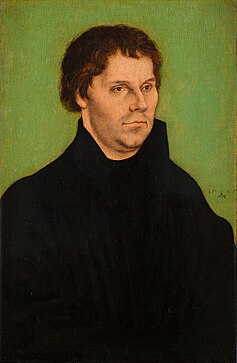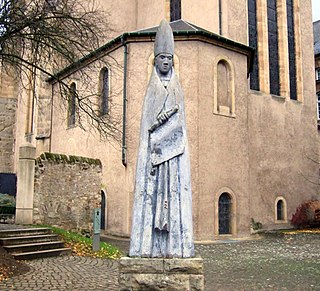Related Research Articles

Elizabeth of Hungary, also known as Saint Elizabeth of Thuringia or Saint Elisabeth of Thuringia, was a princess of the Kingdom of Hungary, Landgravine of Thuringia, Germany, and a greatly venerated Catholic saint who was an early member of the Third Order of St. Francis, by which she is honored as its patroness.

Adso of Montier-en-Der was abbot of the Benedictine monastery of Montier-en-Der in France, and died on a pilgrimage to Jerusalem. Biographical information on Adso comes mainly from one single source and has come under question, but the traditional biography depicts him as an abbot who enacted important monastic reform, as a scholar, and as a writer of five hagiographies. His best-known work was a biography of Antichrist, titled "De ortu et tempore Antichristi", which combined exegetical and Sibylline lore. This letter became one of the best-known medieval descriptions of Antichrist, copied many times and of great influence on all later apocalyptic tradition, in part because, rather than as an exegesis of apocalyptic texts, he chose to describe Antichrist in the style of a hagiography.
Blessed Gebhard von Salzburg, also occasionally known as Gebhard of Sussex, was Archbishop of Salzburg from 1060 until his death. He was one of the fiercest opponents of King Henry IV of Germany during the Investiture Controversy.

Saint Rumbold was an Irish or Scottish Christian missionary, although his true nationality is not known for certain. He was martyred near Mechelen by two men, whom he had denounced for their evil ways.
Hermann of Fritzlar was a medieval German mystic and author of a collection of legends, the Buch von der Heiligen Leben, also known as Das Heiligenleben, which was written between 1343 and 1349.
Abias is a saint of the Coptic Church. He is included in the Heiligen-Lexicon by J. E. Stadler. A church in Alexandria is dedicated in his name. It is unknown what his feast day was if he ever had one.
Abiatha, Hathes, and Mamlacha were virgins and martyrs of the Beth-Garma province of Syria. The word "Belth" in Chaldaic means "hill", this city was built on a hill in Assyria. They were martyred under Shapur II, about 345 AD. Their feast day is November 20. They are included in the Heiligen-Lexicon by J. E. Stadler. Mamlacha is also a Hebrew word which means "Kingdom".
Abib and Apollo were two Christian ascetics from Akhmim, Egypt. They are mentioned in the Synaxarion, das ist der Heiligen-Kalendar del Koptischen Christen. Their feast day is celebrated on November 4.
Abibion was one of the founders of Bet-Coryph monastery in Byzantine Syria, together with Eusebonas. He also served as first abbot of that monastery. He is included in the Heiligen-Lexicon. He received his instruction from Eusebius. His feast day, if he had one, is unknown.
Saint Eustace of Luxeuil, also known as Eustasius, was the second abbot of Luxeuil from 611. He succeeded his teacher Saint Columbanus, to whom he had been a favorite disciple and monk. He had been the head of the monastic school.
Silvanusof Ahun is venerated as a martyr and saint.
The Buch der heiligen Dreifaltigkeit is an early 15th-century alchemical treatise, attributed to Frater Ulmannus, a German Franciscan.

The Order of Saint Michael or Royal Merit Order of Saint Michael was founded in 1693 by Joseph Clemens of Bavaria, then Archbishop-Elector of Cologne, as a Military order. Initially, this order was only open to the Catholic nobility.

"Nun bitten wir den Heiligen Geist" is a German Christian hymn. The first stanza is a leise from the 13th century which alludes to the Latin sequence Veni Sancte Spiritus for Pentecost. It was widely known, and aside from its Pentecostal origin was also used as a procession song and in sacred plays.

The Miracles of Saint Demetrius, also known by the Latin title Miracula Sancti Demetrii, is a 7th-century collection of homilies, written in Greek, accounting the miracles performed by the patron saint of Thessalonica, Saint Demetrius. It is a unique work for the history of the city and the Balkans in general, especially in relation to the Slavic invasions of the late 6th and 7th centuries, which are otherwise neglected by contemporary sources.

Cwenburh of Wimborne was an 8th-century Anglo-Saxon saint, a sister of King Ine of Wessex and of Saint Cuthburh. Her sister Cuthburh was married to King Aldfrith of Northumbria and then became the first abbess of Wimborne monastery.

Wilgils of Ripon, also known as Wilgisl and Hilgis, was a seventh century saint and hermit of Anglo-Saxon England, who was the father of St Willibrord. His feast day is 31 January.
Die Lügend von S. Johanne Chrysostomo, first published by Martin Luther in 1537, is an edition of the late mediaeval Life of John Chrysostom as a hermit, characterised by Luther's sceptical, and often sarcastic, marginal commentary. It was influential on the decline of the literary form of the Christian legendary.

Claudio Marzocco is an Italian engineer and businessman. He is the chief executive officer (CEO) of Groupe Marzocco, one of the leading real estate development companies in Monaco.
Saint Florus was the legendary first bishop of Lodève. He evangelised in Languedoc and the Auvergne, and was martyred in about 389.
References
- Holweck, F. G. A Biographical Dictionary of the Saints. St. Louis, MO: B. Herder Book Co. 1924.
| This article about a saint is a stub. You can help Wikipedia by expanding it. |
| This article about a reference book is a stub. You can help Wikipedia by expanding it. |
| This article about a biographical or autobiographical book on Christian personalities is a stub. You can help Wikipedia by expanding it. |